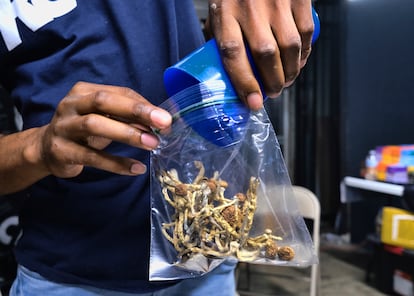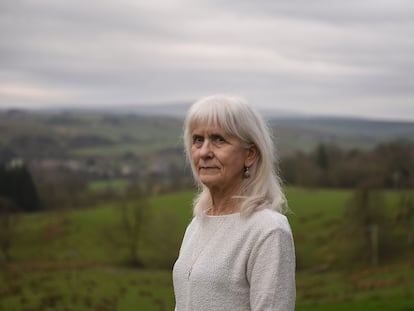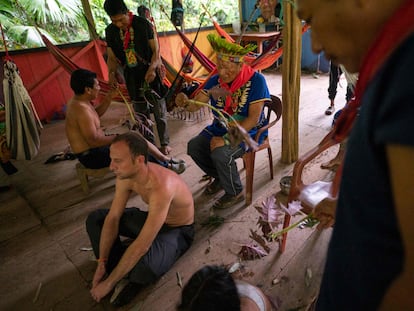The ‘psychedelic renaissance’: Science revives therapeutic potential of psychoactive drugs
Australia has become the first country to allow MDMA to be prescribed for patients suffering from post-traumatic stress disorder

Psychedelic drugs are gaining ground in medicine. After decades of silence — cornered by prohibitive laws and the smear campaign waged by the Nixon administration in the 1970s – scientific research into the effect of MDMA, LSD, ketamine or psilocybin (present in hallucinogenic mushrooms) has flourished again. Scientists are looking to exploit these drugs for their potential contributions to therapeutic mental health treatments.
With already-existing evidence, new findings are now beginning to become part of clinical practice. For instance, esketamine, a derivative of ketamine, is already being administered as a spray for people with resistant depression. Meanwhile, Australia has just become the first country in the world to allow MDMA to be prescribed for post-traumatic stress disorders (PTSD), while psilocybin can now be used to treat depression.
Experts consulted by EL PAÍS admit that, while the research into psychedelic drugs is “promising,” the consistency of the benefits — as well as the knowledge about how these therapies should be implemented — is limited. They’re asking for caution, since these drugs aren’t helpful for each and every patient or medical condition.
Psychedelics are ancient drugs. There are post-paleolithic cave paintings in Cuenca, Spain, which suggest the presence of fungi with neurotrophic effects. Mushroom petroglyphs have also been found on large rocks in Siberia, while the use of almost 20 species of psilocybin mushrooms for shamanic rites in Mexico is well-known. Whether in leisure contexts or in healing rituals, psychedelic substances have never gone away but today, they’re gaining more and more prominence thanks to science, says Joana Bauzà, a psychiatrist at the Sant Pau Hospital in Barcelona who is trained in MDMA-assisted therapy.
“The latest research and the change in public opinion have led to the so-called ‘psychedelic renaissance,’ where scientists [use] these substances to treat diseases,” Dr. Bauzà notes. In 2021, the academic journal Science recognized a work published in Nature Medicine as containing a significant finding: the study proved the efficacy of MDMA in reducing symptoms stemming from PTSD. Two months after the therapy, 67% of those who received the psychedelic drug no longer met the diagnostic criteria for this disorder, compared with 32% in the control group.
There’s a list of candidates that have therapeutic potential. Esketamine — a synthetic variant of ketamine, but without as many hallucinogenic and psychedelic effects — is already on the market for resistant depression. And, the following drugs are in line to be endorsed by regulators, or have been approved in Australia: MDMA for PTSD treatments and psilocybin for patients living with depressions that are resistant to conventional therapies. There are also studies that show how psilocybin can benefit those who have eating disorders, or patients going through end-of-life treatment. Research with ayahuasca and DMT (derived from the plant) has shown that these can help prevent prolonged grief or depression. 5-MeO-DMT — which is extracted from the Bufo toad — is also being tested to treat those living with severe depression, while alkaloid ibogaine, found in the root of a Central African shrub, may help reduce opioid dependency.
All of the aforementioned derivatives, to a greater or lesser extent, alter one’s state of consciousness and act on various areas in the brain. “They act differently from classic antidepressants and have more immediate effects,” sums up Víctor Pérez, head of psychiatry at the Hospital del Mar in Barcelona. His center recruited patients for an international study utilizing psilocybin, which was published in the prestigious New England Journal of Medicine. A single dose was able to reduce the effects of resistant depression.
In practice, psychedelic therapy is like a kind of trip. Patients live mystical experiences: they feel an increase in the intensity of emotions, sensations of synesthesia and a dissolution of the ego. It’s as if they’re disconnected from the world and they may even revisit past experiences. “There’s a higher capacity to connect ideas and memories,” says Óscar Soto, a psychiatrist and president of the Spanish Society of Psychedelic Medicine (Sempsi). With MDMA, for example, patients are able to revisit a traumatic situation without running away from it.
While these drugs don’t have high addictive potential, Dr. Soto emphasizes that they must be accompanied by psychotherapy, along with support from professionals during the psychedelic experience — patients should never be left alone while consuming these substances. “We know that the environment where [the substances] are taken and the preparation are fundamental. Music, for example, is important, because it conditions a series of effects… in a psychedelic state, in which sensitivity to the environment is very high, it can be cathartic,” he explains. You have to prepare a safe space and give the patient strategies to manage complex experiences on this psychological journey. The role of the therapist — who must have specific training — is to help navigate this experience. “The person is accompanied, so that they don’t run away from what arises, because [the experiences are] very rich material to be used later in the psychotherapy,” Soto adds.

What happens in the brain during these experiences is still being studied. There are changes in brain neuroplasticity, along with neurocognitive alterations. In two sessions, the same patient can go through two completely different experiences with the same substance.
“Classic psychedelics — such as LSD, psilocybin or ayahuasca — act on the 5-HT2A serotonin receptor. It causes a generalized depolarization of pyramidal neurons, [which] causes various areas of the brain to be better connected. This results in a greater flow of information... mystical experiences may have to do with this dissolution of neurons. On the other hand, dissociative anesthetics — such as ketamine and esketamine — act on the NMDA receptor and cause somewhat different effects,” Soto explains.
The research is still ongoing. Soto, for example, is recruiting patients for a study of psychotherapy-assisted ayahuasca, for people going through prolonged periods of grief after loss. Rosa Dueñas, a psychiatrist and psychotherapist in Barcelona, will be starting a phase II trial in September, looking into the effects of 5-MeO-DMT on resistant depressions: “This substance acts on serotonin reuptake receptors and — depending on [how it’s administered] — has a much faster effect. Via inhalation, the effects appear in seconds and, after 30 or 45 minutes, they’re over. For [this drug] to be effective, it must be supported by psychotherapy before and after [the psychedelic experience],” she explains. Preliminary trials with this substance — which originally comes from plants and a Bufo toad in the Sonoran Desert, in the USA and Mexico — are “promising,” with up to 75% efficacy, Dueñas affirms. However, the studies to date have been small. More research is needed to verify this statistic.
A controversial decision in Australia
The experts consulted agree that the available evidence on the potential of these substances is “promising,” but there’s still a long way to go. That’s why Australia’s decision — which, after July 1, allowed for the prescription of MDMA and psilocybin — has been so controversial among the scientific community. In an open letter in the Australian & New Zealand Journal of Psychiatry, a group of researchers who study these substances rejected the decision. “Sufficient levels of evidence have not yet been generated for broad-scale implementation to be justified,” they argue. The scientists warned that there are still questions to be resolved, such as which are the best models of psychotherapeutic care, or how to identify the patients who would benefit the most. “Until these questions have been addressed in empirical research, the decision to increase public access outside of clinical trials is questionable, if not concerning,” the letter concludes.
Bauzà, who is also a member of Sempsi, agrees that the Australian government should “have waited for more consistency and scientific evidence.” This therapy isn’t innocuous: “One of the biggest risks is that the potential of psychedelics is overestimated and that people read this and [decide] to use it on their own [or] with untrained people. If it’s taken in unsuitable environments, the harmful effects can be very significant,” she warns. For example, psychedelics aren’t recommended for people with previous psychedelic-induced episodes or a family history of psychosis. “One of the risks is re-traumatization if you have experiences [while on the drugs] that you cannot manage. You may also remember things that you didn’t remember [initially] — this can become traumatic and create a new problem. And another risk is that of worsening the disease if there aren’t adequate controls in place,” the psychiatrist from the Sant Pau Hospital states. Her center — which has an esketamine unit — will also participate in the study with 5-MeO-DMT.
Not all substances have the same efficacy, nor are they valid for everyone. “What happened in Australia could end in a setback, because if [the policy] isn’t implemented correctly — accompanied by good psychotherapy and infrastructure — it can lead to traumatic experiences,” Soto insists. Bauzà has reinforced this message to the public. “[This] is a very important door that has opened within psychiatry, but it must be understood that [psychedelic drugs] are not the salvation for all ills.”
Bauzà sees Australia’s decision as premature. “When [psychedelics] were banned in 1971 it was because their use began to spread as a remedy and produced negative consequences and problems associated with consumption. And now, we fear that this will be repeated: we’ve been [dealing with] a stigma and a huge lack of resources and now, by rushing, the same thing could happen again. The biggest challenge is not so much the efficacy of the substance itself, but how you’re going to go about using it as a treatment.”
The research looks good, but many doubts remain to be resolved, agree the scientists consulted by this newspaper. To begin with, it’s necessary to corroborate the evidence of the efficacy of these substances in trials with more patients, clarify the profiles of which patients will benefit the most, while determining the most beneficial types of psychotherapy. The appropriate therapeutic environment would also have to be set up, Soto maintains, with adequate infrastructures and training for professionals. It’s also necessary to reinforce the ethical commitments, so as to avoid abuses in the sessions, the psychiatrist emphasizes. “The framework that guarantees patient safety must be very clear.” For instance, there can be no violence and no sexual contact. It’s recommended that there are always two therapists present — a man and a woman — and that the sessions be recorded.
Risks must be minimized, Bauzà points out. “The code of conduct is super important, which differentiates the clinical aspect from the rituals. The patient has a bit of consciousness… but decision-making is altered. Whatever happens [in the sessions] has to be controlled. The person is very vulnerable and we have to protect them, because we can do a lot of good, but also a lot of harm.”
Pérez thinks that, while the severe dissociative symptoms caused by psychedelics were temporary in the trials and the drugs seem safe, “a long-term therapeutic model is lacking.” The psychiatrist knows that these substances will open a door for “patients who had no chance,” but still calls for prudence. He currently has a patient on the waiting list who participated in the trials and “immediately improved,” before subsequently relapsing. And he knows that these drugs can be an opportunity, but not before the research is complete. “There isn’t enough evidence to put [these drugs] on the market,” he concludes.
With the hope of effectiveness on one hand — and the deficiencies in the implementation on the other — the most “sensible” thing, Bauzà advises, is to wait. “There’s a lot at stake. We’ve been waiting for 30 years [to study these treatments]. It’s ok if we wait a little while longer.”
Sign up for our weekly newsletter to get more English-language news coverage from EL PAÍS USA Edition
Tu suscripción se está usando en otro dispositivo
¿Quieres añadir otro usuario a tu suscripción?
Si continúas leyendo en este dispositivo, no se podrá leer en el otro.
FlechaTu suscripción se está usando en otro dispositivo y solo puedes acceder a EL PAÍS desde un dispositivo a la vez.
Si quieres compartir tu cuenta, cambia tu suscripción a la modalidad Premium, así podrás añadir otro usuario. Cada uno accederá con su propia cuenta de email, lo que os permitirá personalizar vuestra experiencia en EL PAÍS.
¿Tienes una suscripción de empresa? Accede aquí para contratar más cuentas.
En el caso de no saber quién está usando tu cuenta, te recomendamos cambiar tu contraseña aquí.
Si decides continuar compartiendo tu cuenta, este mensaje se mostrará en tu dispositivo y en el de la otra persona que está usando tu cuenta de forma indefinida, afectando a tu experiencia de lectura. Puedes consultar aquí los términos y condiciones de la suscripción digital.
More information
Archived In
Últimas noticias
Raúl Rocha, from jet-setting with Miss Universe to arms trafficking and fuel theft
80,000 barrels of Mexican oil sent to Cuba: Havana drawn into the US–Mexico clash
Human rights activists, opposition members, and a minor: Maduro’s other political prisoners
Israel sparks a civil war within the MAGA movement
Most viewed
- Reinhard Genzel, Nobel laureate in physics: ‘One-minute videos will never give you the truth’
- Pablo Escobar’s hippos: A serious environmental problem, 40 years on
- Charles Dubouloz, mountaineering star, retires at 36 with a farewell tour inspired by Walter Bonatti
- Why we lost the habit of sleeping in two segments and how that changed our sense of time
- The fall of a prolific science journal exposes the billion-dollar profits of scientific publishing











































